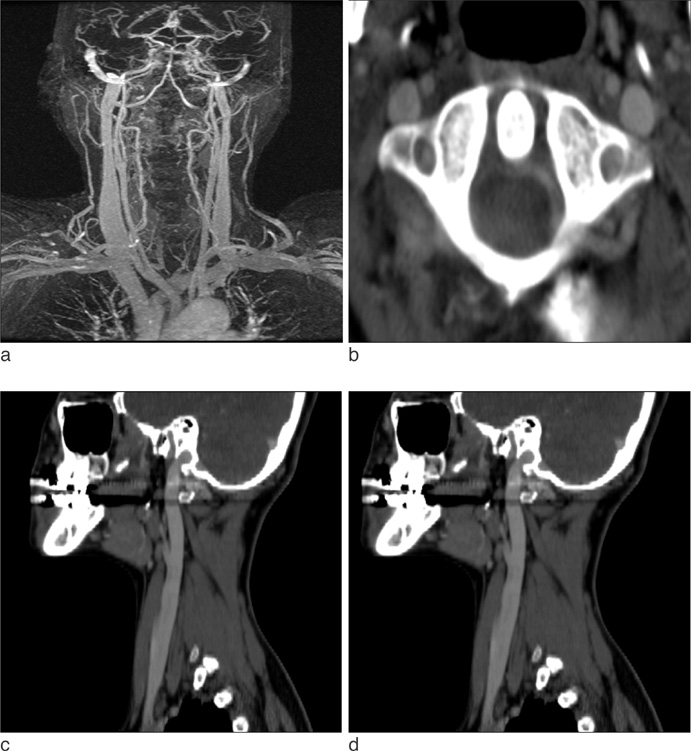J Korean Soc Magn Reson Med.
2011 Apr;15(1):41-47. 10.13104/jksmrm.2011.15.1.41.
Evaluation of the Cause of Internal Jugular Vein Obstruction on Head and Neck Contrast Enhanced 3D MR Angiography Using Contrast Enhanced Computed Tomography
- Affiliations
-
- 1Department of Diagnostic Radiology, Gangnam Severance Hospital, Yonsei University Health System, Korea. tschung@yuhs.ac
- KMID: 2041226
- DOI: http://doi.org/10.13104/jksmrm.2011.15.1.41
Abstract
- PURPOSE
To evaluate the cause of internal jugular vein (IJV) obstruction on contrast enhanced 3D MR angiography (CE-MRA) using contrast enhanced computed tomography (CE-CT).
MATERIALS AND METHODS
A total number of 30 patients were enrolled, who underwent both head and neck CE-MRA and CE-CT from 2005 to 2008. We defined obstruction group which had IJV obstruction and control group which had no IJV obstruction on CE-MRA. The following parameters were measured from axial images of CE-CT: 1) diameter of IJV; 2) distance between the styloid process and ipsilateral lateral mass of the atlas; 3) maximum area of lateral mass of the atlas. Each parameter was compared between obstruction group and control group.
RESULTS
The diameter of IJV and distance between the styloid process and lateral mass of the atlas at IJV obstruction side in obstruction group were 1.6 +/- 1.0 mm and 4.1 +/- 2.1 mm respectively, which resulted in statistical significance (p<0.01). The maximum area of lateral mass of the atlas at IJV obstruction side in obstruction group was 103.4 +/- 25.3 mm2 which is significantly larger than in control group (p<0.05).
CONCLUSION
We found that the cause of IJV obstruction on CE-MRA could be narrow space between the styloid process and the lateral mass of the atlas, which was related with asymmetric larger area of lateral mass of atlas.
Figure
Reference
-
1. Seoane E, Rhoton AL Jr. Compression of the internal jugular vein by the transverse process of the atlas as the cause of cerebellar hemorrhage after supratentorial craniotomy. Surg Neurol. 1999. 51:500–505.2. Gabella G. Williams P, editor. Cardiovascular system. Gray's Anatomy. 1995. London: Churchill Livingstone;1579–1580.3. Tedeschi H, Rhoton AL Jr. Lateral Approaches to the petroclival region. Surg Neurol. 1994. 41:180–216.4. Gooding CA, Stimac GK. Jugular vein obstruction caused by turning of the head. AJR Am J Roentgenol. 1984. 142:403–406.5. Standefer M, Bay JW, Trusso R. The sitting position in neurosurgery: a retrospective analysis of 488 cases. Neurosurgery. 1984. 14:649–658.6. Chandler JR. Diagnosis and cure of venous hum tinnitus. Laryngoscope. 1983. 93:892–895.7. Nehru VI, al-Khaboori MJ, Kishore K. Ligation of the internal jugular vein in hum tinnitus. J Laryngol Otol. 1993. 107:1037–1038.8. Bosnjak R, Kordas M. Circulatory effects of internal jugular vein compression: a computer simulation study. Med Biol Eng Comput. 2002. 40:423–431.9. Doepp F, Schreiber SJ, Dreier JP, Einhaupl KM, Valdueza JM. Migraine aggravation caused by cephalic venous congestion. Headache. 2003. 43:96–98.10. Alperin N, Lee SH, Mazda M, et al. Evidence for the importance of extracranial venous flow in patients with idiopathic intracranial hypertension (IIH). Acta Neurochir Suppl. 2005. 95:129–132.11. Piagkou M, Anagnostopoulou S, Kouladouros K, Piagkos G. Eagle's syndrome: a review of the literature. Clin Anat. 2009. 22:545–558.12. Ghosh LM, Dubey SP. The syndrome of elongated styloid process. Auris Nasus Larynx. 1999. 26:169–175.
- Full Text Links
- Actions
-
Cited
- CITED
-
- Close
- Share
- Similar articles
-
- A Case of Lemierre's Syndrome, Misdiagnosed as a Simple Deep Neck Infection on Initial Ultrasonography Followed by an Abscess Aspiration Trial
- A Case of Pancreatic Pseudoaneurysm with Aterio-venous Fistula in Acute Pancreatitis
- A Case of External Jugular Vein Thrombophlebitis with Sepsis
- Lemierre's Syndrome Following Acute Tonsillitis
- Preparative fasting before contrast-enhanced computed tomography





